
This article first appeared at The Spinoff, on 16 May 2019, and is republished here with permission.
--
Rip It Up magazine was a godsend to local musicians and music fans when it first arrived in 1977. There was no other publication that took local music seriously in that era of “cultural cringe” and musicians had few nationwide outlets (television or radio) unless they were the poppiest of pop bands doing covers of overseas acts.
Into this vacuum, Rip It Up appeared for free in local record stores, quickly rising to a circulation of 20,000 copies per month. The regional music scenes suddenly had access to what was happening in the next city over and the pages were filled by serious writers who were dedicated to spreading the word about the bands that they loved.
What started out as a throwaway zine went on to last 38 years and provided a megaphone for a huge range of musicians, writers, and creative talents. The current owner, Simon Grigg, has partnered with the National Library and music history website AudioCulture to make the first 21 years of the magazine freely available via the online archive, Papers Past. To celebrate, here’s an account of the magazine’s history, through the voices of those who were there, starting with its two founders.
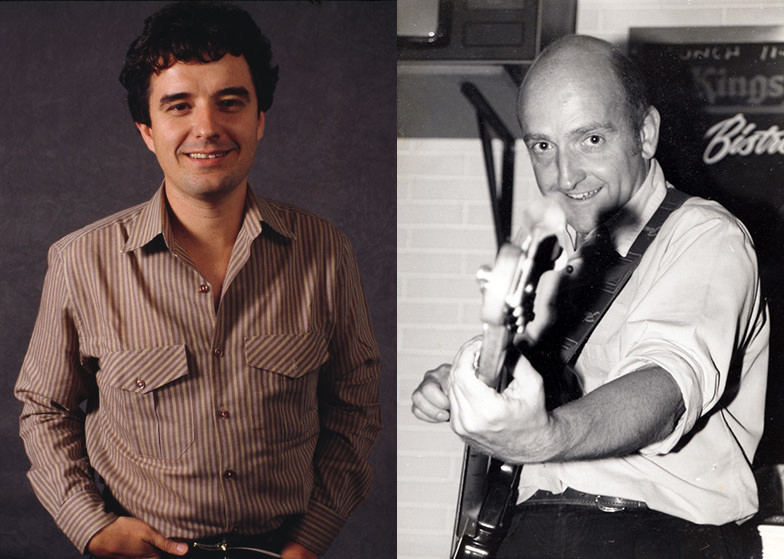
Rip It Up founders Murray Cammick (at left, photo by Jocelyn Carlin) and Alastair Dougal.
Alastair Dougal: I first met Murray in form two but we didn’t become friends until secondary school … When he was 13 years old Murray was obsessed with Otis Redding and was even a member of the Stax appreciation society and imported records from England.
Murray Cammick: The only local music magazine was Hot Licks. I liked it, but because I was a soul fan I didn’t think it had enough black music. Too much prog rock and not enough New Zealand music. That magazine folded while we were at university, leaving a gap. We went to lunch with its founding editor Roger Jarrett and he said that Hugh Lynn was thinking of starting a magazine, so if we wanted to act then we had to do it quickly. We both put in $500.
Alastair: It became legend in my family that when Mum opened a bank account for us, the teller asked “what’s the name of the company?” and was taken aback when she said, “Rip It Up.” Mum was quite staunch so probably enjoyed giving them a shock.

William Dart, 1970s - Roger Raglan
Murray: I was running Snaps gallery on Airedale Street and there was a back office we could use. We needed content quickly so turned to university friends who were really good writers like Bruce Belsham, John Malloy, Frank [Francis] Stark, and Peter Thomson. Alastair had attended lunchtime lectures by this hip young lecturer called William Dart, so we approached him. Rolling Stone had Ralph Gleason as their elder statesman, so we thought we’d have William in that role, despite him only being a few years older.
William Dart: The early columns were quirky – starting with a Janis Ian/Phil Ochs piece and a fan letter to the Beach Boys when they were far from popular (with a drawing by Daryl File). Did one on gay rock, and also a wee rhapsody on Purcell’s Fairy Queen. Great to meet Kim Fowley and write him up. I remember him asking Murray and I where he could find a “nasty girl” in this town. LP reviews were what Murray allotted to me and from issue 25 there were the film reviews. I now contemplate what a lot of hassles there were getting to see some of the movies you were supposed to review, as well as the many hours spent watching films that you now wouldn’t turn on the TV for …
Alastair: I interviewed Mike Chunn in the first issue then also got him to write some reviews. That shows how desperate we were for content.

Rip It Up No.2; Mike Chunn asks Graham Parker for the lyrics to 'Protection', 1978
Mike Chunn: In April 1977 I returned to New Zealand, having left Split Enz. Soon after Alastair and Murray came to interview me. I had known Alastair previously – I sold him my Fender Mustang bass in 1974. Citizen Band had yet to morph and writing has always been an “activity” in my family – my father and sister Louise were great writers – so I asked and RIU gave me a shot.
Murray: EMI had said they’d take several full page ads, but didn’t even take one during the first year. I flew to Wellington to meet the marketing manager for PolyGram and he wouldn’t see me, even though I had an appointment. Though later I did some pretty naive things. Warners wanted five quarter pages for the price of four and we decided not to compromise our rates, so they pulled their ads for the month!
Alastair: I was doing a law degree, which was pretty full on. Murray did a hell of a lot of it. I was just doing the news.
Murray: The idea of having local acts on the cover came from Alastair. I remember saying to him: “Hello Sailor play at the Globe to 50 people, why put them on the cover?” Alastair just said, “Well they’re as good as the overseas bands playing the Town Hall.”

Hello Sailor on Rip It Up issue #3 - the first New Zealand act on the magazine's cover
Alastair: It just seemed obvious – it was our country, we had to cover what was going on, otherwise we’d just be a poor clone of an overseas magazine.
Murray: There was a lot of cultural cringe. In one issue, Bruce Belsham gave the new Marcia Hines album a bad review and said that Mark Williams’ album sounded better. The concept that a locally recorded album could sound better than an album recorded in Australia was considered absolute bollocks by industry people here.
The record company promptly cancelled a full page ad because of it … I did think it was helpful that we sometimes critiqued local bands when they did something average. There’s been a tendency in all areas of the arts to treat artists as if they’re godlike when they’re doing work that’s just okay. Our excess of praise of stuff has destroyed a lot of talent over the years.
Alastair: Writers outside Auckland eventually got in contact. People like George Kay and Roy Colbert who were excited to see a New Zealand music magazine and offered their services.
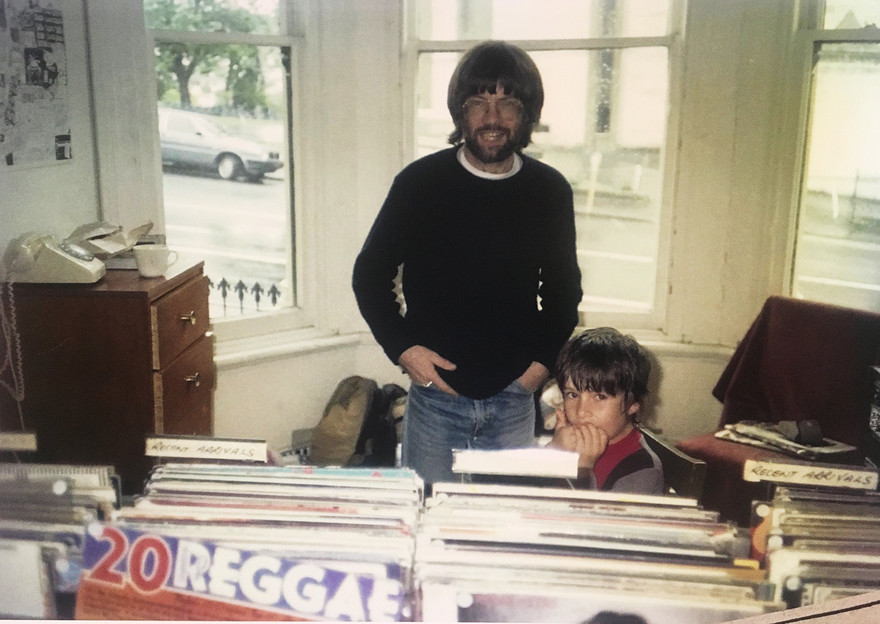
Roy Colbert inside Records Records with son Jesse, Dunedin, 1984. - Pat O'Neill
Jeremy Templer: I’d known Murray from Craccum and got him involved with Hot Licks (where I was co-editor with Roger Jarrett). I’d retreated to Wellington in 1976 after Hot Licks folded. One day when I was back in Auckland, Murray called in a panic because a woman called Debbie Harry was in town and they wanted an interview but no one knew anything about her – Blondie hadn’t yet been released here. I read all the overseas mags I could get a hold of and knew enough to ask the right questions. It helped that I liked the music.
Simon Grigg: The punk scene and Rip It Up arrived at the same time. We soon realised that they understood and would treat the music seriously unlike any other media outlet at the time, until In Touch arrived in Wellington and Colin Hogg at the Auckland Star. Until 1978 nobody else – TV or print – were able to see beyond the Filth and the Fury angle. Rip It Up, however, penned serious profiles of the Suburban Reptiles and The Scavengers in 1977 and Murray was a regular photographer at the gigs. It was also the first outlet to give regular nationwide exposure to regional scenes and it’s hard to overstate that.

Bones Hillman and Jimmy Joy of the Suburban Reptiles, Classic Cinema, Auckland, 3 December 1977 - Photo by Murray Cammick
Murray: It seems stupid now, but I remember once crossing the road to avoid the Suburban Reptiles. And they were at Elam with me! Alastair couldn’t find anyone to review a gig by The Scavengers and the Suburban Reptiles, so Mike Chunn did it because he was a friend of Buster Stiggs. Mike gave Scavengers a good review and Suburban Reptiles a bad review, but Buster always adamantly claimed that Mike just got the band names mixed up …
Mike Chunn: Ha ha! I found it difficult to absorb Buster and his punk world as he’d just months before been in a band called After Hours with Neil Finn and my brother Geoffrey, so it was like having a girlfriend who suddenly had a sex change … And maybe I had too many beers at that gig!
Murray: The turning point was in 1978 when John McCready started up CBS in New Zealand. He phoned me up and said “come over to our office and on your way decide which are the best spaces.” CBS coming in strongly meant the other companies had to come in to have a comparative presence. It would’ve been pretty hopeless otherwise.
Jeremy Templer: I went overseas in August 1978. In London, I interviewed the Cure and did live reviews of the B-52s and Devo for Rip It Up … I also wrote about Hello Sailor for Rip It Up when I was staying with them in the Hollywood Hills, but only briefly, and with much left unsaid.
Alastair: By 1979, my law school commitments were getting more onerous and I was totally overcommitted so Murray took over running the magazine.

Duncan Campbell and friend, in the 2010s. - Duncan Campbell Collection
Murray: By that stage we’d gained talented writers like Ken Williams and Duncan Campbell who both worked at Radio i. Ken would say things like, “you write better than people on the Auckland Star who’ve been there 20 years”, so I started to write more.
Simon Grigg: In June 1980 I started Propeller Records, with a great deal of support from Murray and his staff, especially Mark Phillips … By mid-1980 Murray and I were flatting together. It was a very special time. It also meant that my relationship with the mag was amazing. I had three covers within a year! But Murray was equally supportive of other labels. I don’t think he ever quite got Flying Nun, but the support was strong nevertheless. Other local indie labels like Ripper Records, Reaction, Warrior, and Pagan were hugely covered and none of us could have survived without Murray.
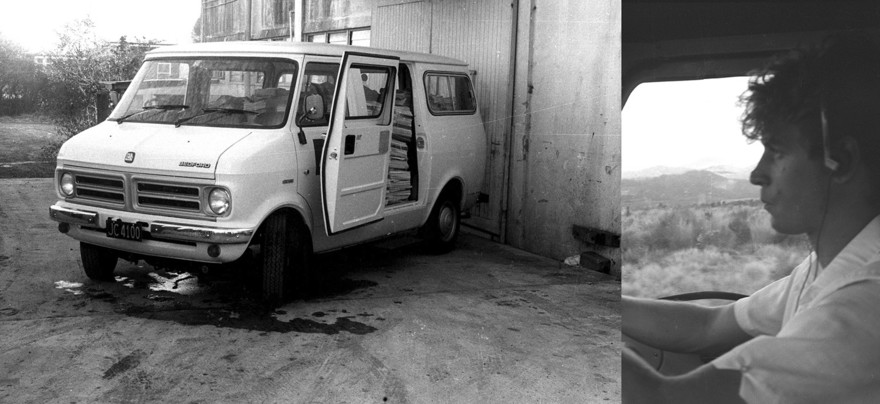
The Rip It Up van in Putaruru, early 1980s, with writer Mark Phillips at the wheel. - Murray Cammick
Murray: At one point, I received this anonymous letter saying that Rip It Up used to be brave, but had just become an advertising rag for the music industry. It was absolutely beautifully written. Every typewriter was different, so you could identify who’d written a page by how it looked. So then a story appeared six months later and I thought – “I know that typewriter!” Russell was obviously a great writer so I wanted to contact him, especially since I was looking for a sub-editor.
Russell Brown: In 1982, I’d gotten friendly with the Dance Exponents who’d come through Timaru where I was working for the Christchurch Star. Later, I visited Christchurch and went to see them at the Hillsborough Tavern. Debbie Harwood was managing them and said: “have you applied for the Rip It Up job? I spoke to Murray and he really wants you to apply.” So I got back home and wrote my application letter. Later Murray turned up on the train and we went to dinner.
He wasn’t quite what I expected. He wasn’t a cool rock dude wearing a leather jacket, let’s put it that way, but we got along really well … Rip It Up had a loft space on Darby Street. Dave Perkins from Taste Records ran Snake T-shirts there with Chris Caddick. On the first floor was Dennis Cohn’s gallery which had openings every second week. There was no lift and a steep narrow staircase up to the top floor. It was difficult carrying things up there. You emerged through a hatch to Rip It Up’s floor.

The young man with a mullet - Russell Brown in the Rip It Up office, c. 1984-5
Murray: Russell used to piss me off because he would turn up looking like he hadn’t slept – he was party central at that time. I’d need an intro for a story and get him to write it and he’d still do a better job than I could. It’s annoying when someone is that good.
Russell: At times, Murray did have words about my lack of productivity. By the same token – I actually churned through an enormous amount of work. For someone who never learnt to type properly, my god I typed a lot … There was a real turning point around 1984 when we went to computer typesetting. We put the whole thing on a floppy disk rather than carrying all the galleys up to Airedale Street to the typesetters. The first time we tried it, a friend who was supposedly a computer expert came in after I’d already entered the entire issue and managed to delete it all on deadline. The next day, I had to re-type the whole fucking thing!
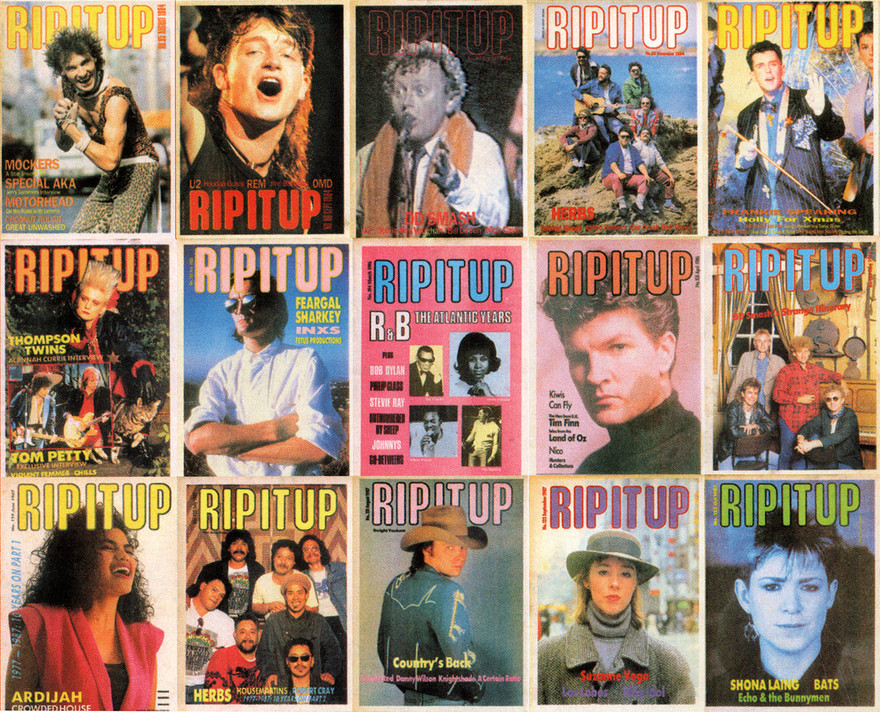
Murray: Chad Taylor came up at one point looking for a job doing layout. I was going to say no, but he mentioned he was at Elam – since he’d be there for 4-5 years, I figured he’d be useful. Another time, this secondary school student from Hamilton, Paul McKessar, came to interview me. He had all these questions, so I kept giving him shorter and shorter answers, but he still had more. I thought – I remember when my brain worked like that! Russell suggested he do a story so he became part of the scene.
Russell: I should take some responsibility for leading Paul astray …
Paul McKessar: I’d come up to Auckland and be helping Yoh from the Meemees, Paul Luker, Ian Dalziel with stuff and annoying Murray, Ange [Jonasson] and Russell with my nerdery … I’d stay with Russell to go to gigs I’d review – the legendary Nitpickers Picnic where the Headless Chickens debuted, Jonathan Richman at the Six Month Club. At bars like DeBretts, I’d slink into the corner when the team policing unit arrived. I never got caught once.

Ian Dalziel, Rip It Up graphic artist, 1986; Murray Cammick, Angela Jonasson, Yoh
Russell: To this day, it’s a problem breaking down male dominance in music writing. Murray was always keen to do that. He brought on board people like Jewel Sanyo [Gill Samuel] and Louise Chunn, who went on to edit The Guardian’s women’s section. When Murray started ChaCha [fashion magazine] and Shake! [pop magazine] that did bring in a few more female writers who ended up writing for Rip It Up as well. Vicky Bogle was this school girl but was extremely enthusiastic about getting involved. After my time, there was Donna Yuzwalk too.

Rip It Up writer Donna Yuzwalk and Jan Hellriegel in the mid-90s
Murray: Donna Yuzwalk said to me that Rip It Up had the whiff of men’s smelly socks.
Louise Chunn: Murray is/was a great enthusiast. It’s not usually a great idea for the editor and publisher to be one and same person – constantly struggling over ads and money and space – but he made it work. He was particularly notable for his enthusiasm for all kinds of music; most music fans stick to their lane, but I always felt he had a genuinely open mind.
Russell: There were times when the finances were really dicey. There was at least one time when Murray was away and money wasn’t coming in, so I funded everyone’s pay off my credit card, though I got the money back.

Murray Cammick in the Rip It Up office, Darby St, Auckland, 1986. - Chris Bourke
Murray: I did Shake! in the mid-80s to separate the Andrew Fagans and Billy Idols into a teen idol magazine and I got Chris Bourke on board to push Rip It Up towards a more adult readership. I wanted to make clear that Rip It Up was a magazine for adults, since we somewhat relied on ads from the alcohol industry. The ads that got us into trouble were the ones with Dave Dobbyn.

At left, Chris Bourke in the Rip It Up office, Darby Street Auckland, 1986. Right: DD Smash in the problematic Chardon ad campaign
The old head of Festival Records was working at a wine company and had the idea of linking their cheapest wine with musicians. There were complaints made and the law was changed. They weren’t just looking at Rip It Up, but certainly it became law afterward that you couldn’t use heroes of the young like musicians and All Blacks to advertise alcohol.
Russell: I hadn’t realised how ahead of the game we were in terms of technology until I washed up in London in 86 … All the papers in London had the most stone-age production processes. I did freelance subbing at some of the music papers and the physical galleys would still be taken back-and-forth on a motorcycle.
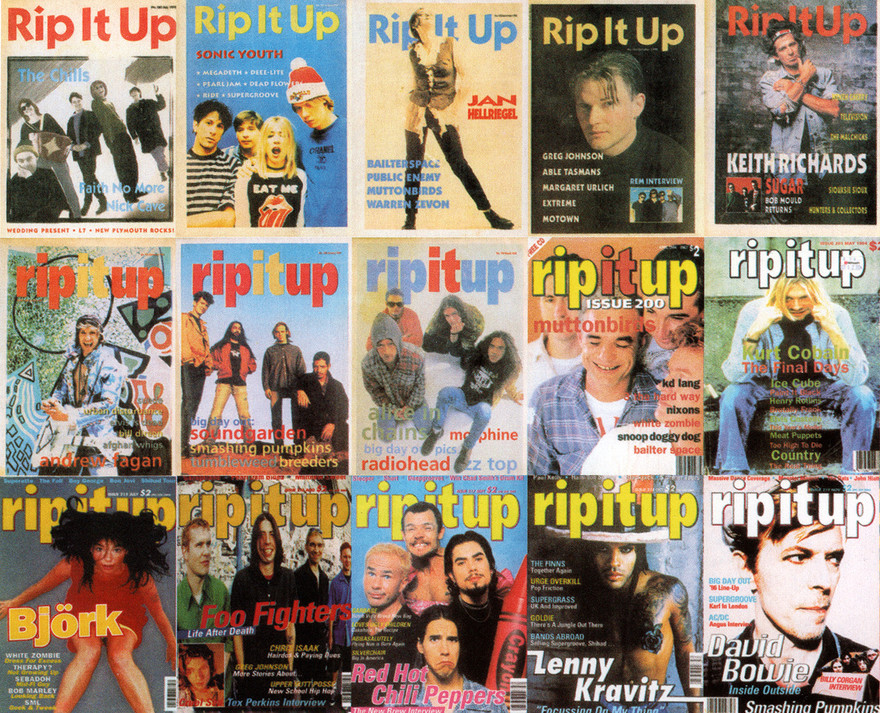
Murray: We rode all these fads that came along – punk, ska, britpop. Grunge was a fantastic era. The magazine got bigger and gained more staff. Kurt Cobain died – that sold some magazines. The Big Day Outs were great – we got some great photos of Courtney Love, Rage Against the Machine and Nick Cave. I stayed on as editor initially when Liberty Group bought the magazine in 1994 and they put a price on the cover.
Even after I finally left as editor when Satellite Media took it over, I continued writing a historic column for them. Some of the later editors were fantastic. When Karl Puschmann took over, someone used to occasionally rewrite my intros of my historic stories and they did a better job than I could’ve! All of the editors did good stuff and suited their time. DJ Sir-Vere was there when local hip hop was big – promoting important work that I still haven’t even listened to!
Phil Bell aka DJ Sir-Vere: Rip It Up and NME were my musical DNA. Rip It Up being free was amazing. When I discovered it, I went up to their offices to buy whatever back issues they had … Becoming editor was just another of those things that I walked into without appreciating it at first. Murray, who I greatly respect, said the first cover I did (with Otis Frizzell) was his favourite cover ever. After I heard that, it got me thinking about the magazine’s amazing legacy, I thought – I’ve got to be really careful how I handle it.

Leonie Hayden - Photo by Lee Rose Gilmour
Leonie Hayden: I was the captain as the ship sank. Not Rip It Up’s last ever editor, but the last of the newsstand era. Though music print media was a sitting duck long before I took over. I was really proud of having that role, but on the other hand, it was the body of work I’m least proud of. If I’d known the ship was sinking, and if I’d been bolder, I would have thrown the Foo Fighters in the bin and turned it into a rad zine for femmes and POC.
The publisher, Nikki Streater from Satellite Media, was a total boss. But the Rip It Up I took over was a totally different creature to Murray’s. It wasn’t grassroots, it wasn’t part of a scene. It was trying to mimic a glossy international title on a street-press budget. We failed miserably at creating a new, original space for music and culture, but I had a real good time doing it.
Murray: Satellite Media didn’t want to be the company that closed it down. It was offered to me very cheaply and my list of reasons why I didn’t want to own it were probably the same reasons that made me start it originally – being invited to record launches, drinking free beer with music industry people, going to see bands every weekend. I’d rather be home watching TV.
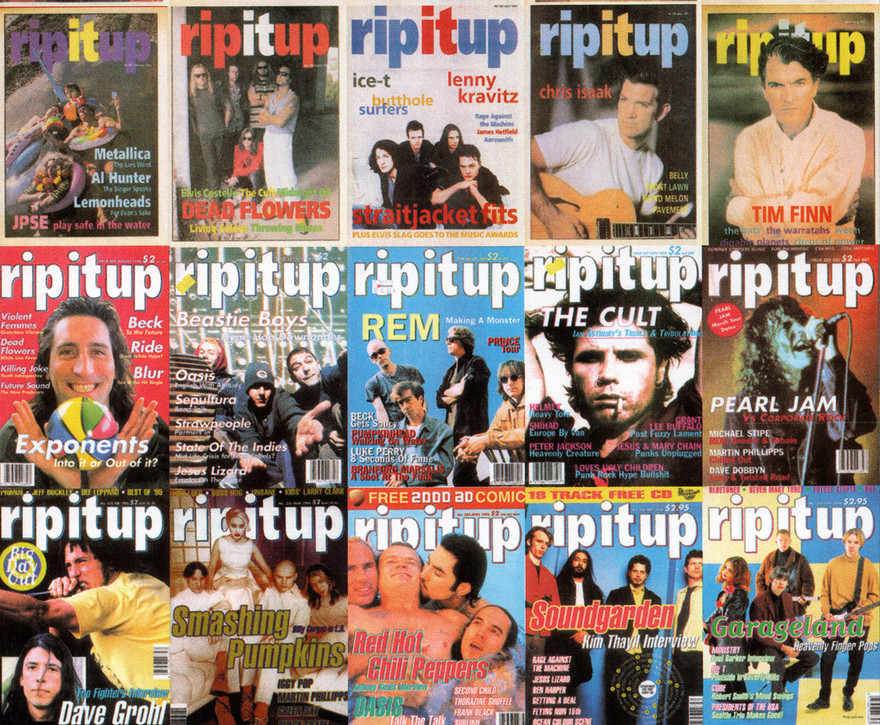
Simon Grigg: Rip It Up staggered to a close in 2015 after a few mixed years (and some great stuff – Leonie was a magnificent editor and Andrew Johnstone’s Phil Judd pieces were amazing). In 2016, Grant Hislop decided to sell the archives so we arranged a deal. Independently I’ve since acquired the name. Rip It Up made me who I am in big part, plus I knew it came with many thousands of images and a vast written library that would be good for the music history website I’d started up, AudioCulture.
I also knew that it was in large part the soul of Murray – one of my very best and most loved friends, and a giant for his incredible achievements. It could not be broken up or sold to a multi-media monster. Buying [the Rip It Up archive] was a no-brainer. So what to do with this thing I’ve bought? Putting it all online was the next obvious thing – free, searchable and saveable. The cost of me doing it was prohibitive plus I wanted it to go the nation as a resource – for schools etc – so I talked with [music curator] Michael Brown at National Library and we began the process.
Chris Bourke: Rip It Up in the Cammick era was like a family for those involved, with Murray the slightly distracted eccentric dad, mustering his staff and outside supporters, crossing off his lists of endless tasks. Teaching through conversation. For the readers Rip It Up was exactly what every magazine should aspire to be: a letter from a close friend sharing their passions.
Mike Chunn: Rip It Up and the TV show Radio With Pictures MADE that era big, bright and beautiful. It’s as simple as that!

Rip It Up, a scrapbook

Murray Cammick arrives with the pizzas during a Photo Forum paste-up session, 1977 - William Dart Collection

Rip It Up party to farewell writer Jeremy Templer, 1978 (L-R): Fritha Saxby, Jeremy Templer, poet Jon Adams (who wrote some early reviews), and Donna Hoyle. - Photo by Murray Cammick

The Androidss in the doorway at the Rip It Up offices in Darby Street, Auckland, early 1981 - Photo by Murray Cammick

Just like I pictured it: Russell Brown in New York in 1989, to interview Youssou N’Dour for Select magazine

Murray Cammick and ChaCha editor Ngila Dickson, at the 10th anniversary party, 1987.

Rip It Up writer John Russell (centre) with Supergroove manager Stuart Broughton (left) and Damon Newton from Dead Flowers

Rip It Up office manager of mid-1980s Sheryl Morris and singer Debbie Harwood

Contributor Simon Grigg and former assistant editor Mark Phillips at the Brat nightclub, Auckland, 1986. - Photo by Murray Cammick

Hugh Lynn's tour company Bedford Jumbo next to Rip It Up's Barina, near Ruatoria for the launch of Herbs' Sensitive to a Smile, 1987. - Photo by Murray Cammick

The Suburban Reptiles wish Rip It Up a Merry Xmas, December 1977 - Murray Cammick Collection

Dave McArtney writes to Rip It Up from Los Angeles, 1978. - Murray Cammick Collection

Hamish Kilgour letter to Rip It Up, 8 December 1980: the night New Zealand heard of John Lennon's death. - Murray Cammick Collection

Hamish Kilgour letter to Rip It Up, 1981 - Murray Cammick Collection
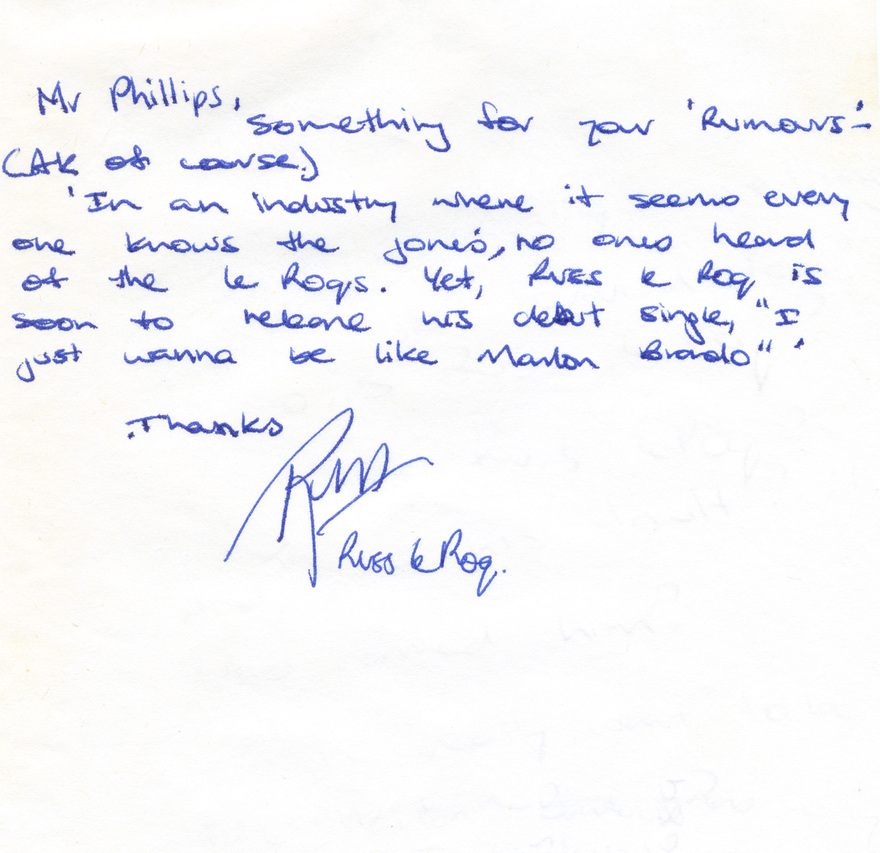
Russ le Roq (Russell Crowe) writes to Rip It Up's Mark Phillips in 1982: "No ones [sic] heard of the le Roqs." - Murray Cammick Collection

The AXEMEN write to Russell Brown at Rip It Up. The letter itself is lost in time.
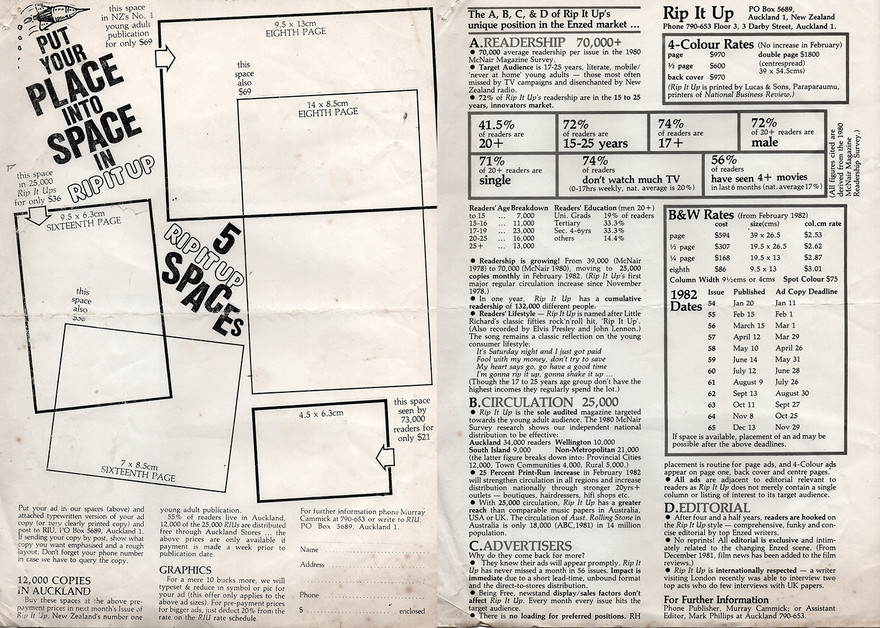
Rip It Up rate card, 1982
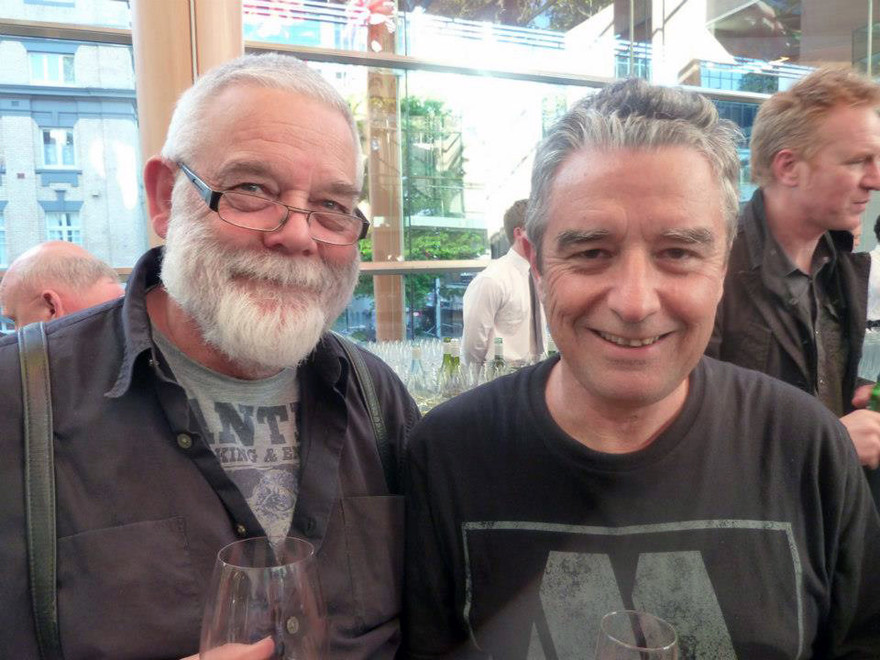
Film columnist William Dart and Murray Cammick swap deadline stories, 2012. - Studio GuiDon
When Rip It Up celebrated its 10th birthday in 1987, Dylan Taite produced an item about the magazine for TV's Top Half.